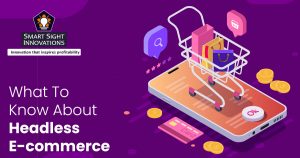 A smooth online purchasing experience that is quick and simple to use is what your customers need. Their purchasing behavior has changed too wherein they use everything from smartphones to speech devices like Google Home to make purchases while on the go. A huge chunk of online shopping is through websites and e-commerce platforms.
A smooth online purchasing experience that is quick and simple to use is what your customers need. Their purchasing behavior has changed too wherein they use everything from smartphones to speech devices like Google Home to make purchases while on the go. A huge chunk of online shopping is through websites and e-commerce platforms.
As an e-commerce store that desires a successful enterprise, you must look towards providing a prompt and better purchasing experience and increasing sales. Many retail and e-commerce brands have turned to headless e-commerce which is an innovative approach to online shopping to meet customer expectations.
What Is Headless E-commerce?
Headless e-commerce enables companies to build and operate an online store without the use of a conventional web interface and with API-powered back-end activities. In simple terms, headless e-commerce is splitting the store’s front end from the back end.
Such disconnection paves the way for the development of a flexible framework and modeling this framework to fit your company’s demands gets significantly simpler, in turn giving your customers a better shopping experience. Brands like Netflix, Amazon, Uber, etc. have adopted the headless e-commerce system.
Headless e-commerce allows you to make changes to the customer-facing side of your e-commerce store without having to touch the back-end store processes that control shopping carts, shipping orders, tax calculations and much more. Likewise, you can make adjustments to the back-end procedures without impacting the front-end components that include the websites, UX and UI where customers engage with the store.
Moreover, to give customers access to the same goods and services regardless of the device they are using, businesses can use headless e-commerce to develop a uniform shopping experience across a number of gadgets like smartphones and tablets.
Headless E-commerce vs. Traditional E-commerce
A traditional e-commerce platform (often known as a monolithic approach to e-commerce) includes a UI that has been designed for administrative staff and customers. However, headless e-commerce enables you to break these constraints and create experiences that can be customized on both sides.
Meeting needs specific to your brand becomes simpler because of this. Traditional e-commerce stores are unable to meet the current online retail standards as they were primarily designed for desktop use.
It is time-consuming and keeps the customers waiting. The store loses a lot of potential traffic and revenue that originates from other devices and sources since it cannot provide the necessary UX and UI.
Making changes and updates in just the front-end or back-end component becomes impossible. When something needs an update the developers have to go back and forth making changes to both the front end and the back end, slowing development time and increasing site breaks.
Benefits of Headless E-commerce
Headless e-commerce can improve the consumer experience, provide more customization options and enable operational flexibility. The following are some of the main advantages of headless e-commerce:
1. Customer reach and interaction
Headless e-commerce helps increase multi-platform and multi-channel prospects. As a result, you can allow your store to handle requests coming from a variety of gadgets. Headless e-commerce enables you to develop many touchpoints with the user which leads to a broader audience.
2. No limits to UX/UI and personalization
There are essentially no design or idea execution restrictions for headless e-commerce. As there is no predetermined front-end layout, you can decide how the headless storefront will look and what features it will include for your sales channel. You are free to design your UX and UI clutter-free, nice and neat, with any device and touchpoint.
3. Quick development and implementation
Updates and integrations for an e-commerce website can take up to a few weeks in a conventional setup. But, in a headless e-commerce setting, integrations are driven via APIs, allowing a speedy and smooth flow of data. The direct communication between software platforms like CRM, marketing automation and CMS to name a few, helps in quick and flexible integrations.
4. Scalability
As trends develop and your business adjusts accordingly, headless e-commerce enables you to modify your front end. The APIs allow you to add back-office functions to your existing system rather than building a new website from the beginning.
5. It increases speed and efficiency
A headless e-commerce platform can help firms automate many of their activities thus increasing productivity and reducing costs. It can also assist businesses cut back on their use of IT staff, saving money in the process. Headless e-commerce enables brands to work with the front end of their choice be it CMS, DXP, PWA or a custom e-commerce solution, while simultaneously selecting the e-commerce platform that functions best as the engine for their online store.
6. Improved client services
The best headless e-commerce platforms enable An excellent customer experience as they allow you to customize the UX to suit unique needs creating a more individualized experience. It also helps businesses enhance the usability and dependability of their website, which will enhance the entire client experience.
Drawbacks of Headless E-commerce
Headless e-commerce can change a company’s operations in various ways to enable additional connections. But more integrations mean more effort, expense and complexity. Hence, when installing a headless e-commerce platform you need to consider both its benefits and drawbacks. Some drawbacks are:
1. Expensive
Separating the front end from the back end creates two distinct systems, which require individual hosting and managing. This increases costs. The upfront expenditures to set up or migrate to a headless platform environment, as well as continuous costs to test and deploy all the potential new consumer touchpoints, are in addition to the infrastructure costs.
2. Complex
As opposed to one interdependent, traditional e-commerce platform, businesses will have to deal with numerous suppliers and technologies, each with its own set of faults and security vulnerabilities as well as its installation, configuration, troubleshooting and support procedures.
3. Isolation
Companies are no longer able to see a preview of the content and how it will look on the user’s device or screen due to the lack of a front-end presentation layer. They will have to rely on another department to create, approve and publish content promptly.
Should All E-commerce Stores Use Headless E-commerce?
A headless e-commerce platform is a smart choice for companies with a lot of room to grow. Brands increase web capabilities as the project develops to enhance the client experience. Below are some businesses that can benefit from the use of headless e-commerce.
-
Businesses that seek to adopt an omnichannel approach
Using headless e-commerce solutions will help in compiling all content and product data to provide customers with easy access to the online shopping channels they prefer.
-
Brands that seek flexibility
Headless e-commerce helps organizations introduce new services quickly even when consumer preferences change overnight, making it extremely nimble and flexible.
-
Organizations looking to enhance the client experience
By implementing a headless e-commerce platform you can customize user experience while enhancing online performance.
Headless e-commerce can help you run your business more efficiently and give customers a better overall experience. While headless e-commerce may not be the best option for every business, for some it offers a way to address problems that were impossible earlier.
There is a headless solution that can satisfy your business needs regardless of whether you’re searching for B2C or B2B e-commerce. These solutions provide exceptional e-commerce functionality and optimization opportunities.2













